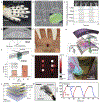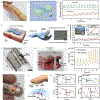Skin-interfaced sensors in digital medicine: from materials to applications
- PMID: 32510052
- PMCID: PMC7274218
- DOI: 10.1016/j.matt.2020.03.020
Skin-interfaced sensors in digital medicine: from materials to applications
Abstract
The recent advances in skin-interfaced wearable sensors have enabled tremendous potential towards personalized medicine and digital health. Compared with traditional healthcare, wearable sensors could perform continuous and non-invasive data collection from the human body and provide an insight into both fitness monitoring and medical diagnostics. In this review, we summarize the latest progress of skin-interfaced wearable sensors along with their integrated systems. We first introduce the strategies of materials selection and structure design that can be accommodated for intimate contact with human skin. Current development of physical and biochemical sensors is then classified and discussed with an emphasis on their sensing mechanisms. System-level integration including power supply, wireless communication and data analysis are also briefly discussed. We conclude with an outlook of this field and identify the key challenges and opportunities for future wearable devices and systems.
Keywords: digital health; electronic skin; flexible electronics; soft materials; wearable sensors.
Figures











References
-
- Ray TR, Choi J, Bandodkar AJ, Krishnan S, Gutruf P, Tian L, Ghaffari R, and Rogers JA (2019). Bio-Integrated Wearable Systems: A Comprehensive Review. Chem. Rev 119, 5461–5533. - PubMed
-
- Wang C, Wang C, Huang Z, and Xu S (2018). Materials and Structures toward Soft Electronics. Adv. Mater 30, 1801368. - PubMed
-
- Someya T, Bao Z, and Malliaras GG (2016). The rise of plastic bioelectronics. Nature 540, 379–385. - PubMed
-
- Yang Y, and Gao W (2019). Wearable and flexible electronics for continuous molecular monitoring. Chem. Soc. Rev 48, 1465–1491. - PubMed
Grants and funding
LinkOut - more resources
Full Text Sources
